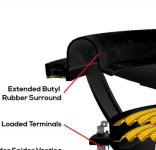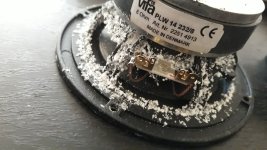Last time, the danish sold me loudspeakers with fake plastic chassis that was really made of cheap magnesia cast. And now they're telling me that crumpled foil could add enough of stiffness to make a loadspeaker functioning.
Any opinions on that?
Assuming the +/- 20% of radiating piston area deviation claim is a joke to focus on possible relevance of cone surround (see partial screenshot from dayton ultimax indicating hat piston area doesn't really change due to rolling, but at the same time, getting stiffness force roughly linear in [un-]rolled area), what about aging crumpled foil then? According to wavecor measurements, even standard formed surround appears to have notable initial stiffness change.
Any opinions on that?
Assuming the +/- 20% of radiating piston area deviation claim is a joke to focus on possible relevance of cone surround (see partial screenshot from dayton ultimax indicating hat piston area doesn't really change due to rolling, but at the same time, getting stiffness force roughly linear in [un-]rolled area), what about aging crumpled foil then? According to wavecor measurements, even standard formed surround appears to have notable initial stiffness change.
Attachments
These surrounds seem to have a planned, steep stiffness rise (anti rubber band like) with voice coil excursion.
I do not have so much thoughts about that, but feel a little eased from that information. It might make some sense to intentionally add such a non-linearity.
Well, and maybe it helps to discard thoughts like: Why don't speaker manufacurers don't ever use metal spirals to make well defined, linear stiffness!

I do not have so much thoughts about that, but feel a little eased from that information. It might make some sense to intentionally add such a non-linearity.
Well, and maybe it helps to discard thoughts like: Why don't speaker manufacurers don't ever use metal spirals to make well defined, linear stiffness!
It's annoying to see such a huge percentage of loudspeakers seems to be unusable, more or less. The cone ones in particular. Hifi-Compass appears to like dome ones.
Where to find drivers like this Beyma 5M30?
Where to find drivers like this Beyma 5M30?
A somehow similar device might be Wavecor WF146WA02. According to it's datasheet, it has a matching Sd (95 vs 90 cm²), similar moving mass (10g vs 8g) and perfectly matching BL of 6.4 N/A, only sensitivity is (somehow unexplained) about 3 dB less.Where to find drivers like this Beyma 5M30?
A test shows a slightly different SPL response, calculates Mms to 13.1g and BL to 7.9 N/A, shows almost no K2 (!) distortion at 85 as well as (rising fast, but still almost none) at 95dB, and K3@85dB from 1.5kHz on above 0.5% peaks to 0.8%, and k3@95dB from 1kHz on above 0.5%, above 1% from 1.5kHz, peaks at 1.5%.
What diy resource would have pointed me to that driver?
The point was that purify claims piston area modulated by [up to] +- 20% with typical other manufacturer's surrounds, and presents their extra-non-linear surround as a solution (to a problem that probably doesn't exist [as described]).
And given their approach of using a non concentric form for the surround, it'll require deformation energy to be thermically absorbed by the (undefined) material, a process that could easily be much more sensitive to aging material, compared to a relatively harmless Cms change. So my question was about long term experience with such speakers. Or maybe today's knowledge about materials for surrounds is that advanced that aging appears to be mostly a yesterday's prob? Only because we've heard about some drivers did have probs with that in the past probably doesn't really mean a thing (even more given that some old speakers still work well, hopefully not just because they did use normal surrounds).
And given their approach of using a non concentric form for the surround, it'll require deformation energy to be thermically absorbed by the (undefined) material, a process that could easily be much more sensitive to aging material, compared to a relatively harmless Cms change. So my question was about long term experience with such speakers. Or maybe today's knowledge about materials for surrounds is that advanced that aging appears to be mostly a yesterday's prob? Only because we've heard about some drivers did have probs with that in the past probably doesn't really mean a thing (even more given that some old speakers still work well, hopefully not just because they did use normal surrounds).
Ah OK. Member bforce has raised the same doubts about Purify's Sd Modulation claims in another thread. Aging, however, has not yet been a topic of discussion.
Looks like I was wrong in comparing the 5m30 with wf146.
All these number and graphs in different styles are difficult to interpret correctly. As can be seen in the following diagrams, I've tried to put some of those mids together using
a) old K+T measurements for the monacor, the wf146 and the visaton. The data was given as linear percentages for 85dB and 95dB, which I mixed using VirtuixCad calculation tool's average function (appeared like it was a dB-average, but not yet sure)
b) a current hooby-hifi measurement for the mr120
c) the beyma datasheet already linked above using the finite volume standard backcap result
All using the SPL reading tool from virtuixCad, which required a lot of manual correction, and since I'm new to using that tool, expect a lot of bugs!


All these number and graphs in different styles are difficult to interpret correctly. As can be seen in the following diagrams, I've tried to put some of those mids together using
a) old K+T measurements for the monacor, the wf146 and the visaton. The data was given as linear percentages for 85dB and 95dB, which I mixed using VirtuixCad calculation tool's average function (appeared like it was a dB-average, but not yet sure)
b) a current hooby-hifi measurement for the mr120
c) the beyma datasheet already linked above using the finite volume standard backcap result
All using the SPL reading tool from virtuixCad, which required a lot of manual correction, and since I'm new to using that tool, expect a lot of bugs!
Given that the clear winner in those HD diagram is the Beyma, which seems to be out of production, or isn't mentioned on the Beyma website, I searched hifi-compass for similar distortion class speakers.
The only Beyma there is a little worse but would still look good in the diagram. Thanks to the multiple voltage plots at hifi-compass, it somehow reminds me of Dayton rs52-an or Scan-speak 10f.
Affordable real mid-range, matching speakers wold be SB Accoustics SB17NBAC + SB15NBAC or maybe Scan-speak 18m4631.
Too expensive for me: Even better ones would be Bliema m142, and maybe Scan-speak 18WU/8741T00 + 8WE/8542T00, haven't really checked out if one of those gets near to the purify ones. Maybe HD isn't the whole thing.
The only Beyma there is a little worse but would still look good in the diagram. Thanks to the multiple voltage plots at hifi-compass, it somehow reminds me of Dayton rs52-an or Scan-speak 10f.
Affordable real mid-range, matching speakers wold be SB Accoustics SB17NBAC + SB15NBAC or maybe Scan-speak 18m4631.
Too expensive for me: Even better ones would be Bliema m142, and maybe Scan-speak 18WU/8741T00 + 8WE/8542T00, haven't really checked out if one of those gets near to the purify ones. Maybe HD isn't the whole thing.
- Home
- Loudspeakers
- Multi-Way
- Crumpled foil surround


